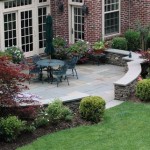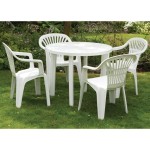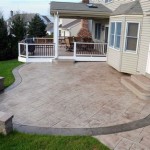Keep Your Patio Looking Great With These Easy Cleaning Tips And Tricks
Maintaining a patio’s aesthetic appeal requires consistent effort and the application of effective cleaning strategies. Outdoor spaces are exposed to a variety of environmental elements, including dirt, debris, mold, algae, and staining agents, which can diminish their appearance over time. Regular cleaning not only enhances the visual appeal of the patio but also prolongs the lifespan of the materials used in its construction. This article provides practical tips and tricks for keeping a patio in optimal condition.
Regular Sweeping and Debris Removal
The foundation of any patio cleaning routine involves regular sweeping to remove loose dirt, leaves, and other debris. This practice prevents the accumulation of organic matter, which can contribute to staining and mold growth. The frequency of sweeping depends on the surrounding environment; patios located near trees or gardens may require more frequent attention. A stiff-bristled broom is generally suitable for most patio surfaces, including concrete, stone, and brick. For delicate surfaces, a softer broom may be necessary to avoid scratching or damage.
Beyond sweeping, removing larger debris, such as fallen branches and discarded items, is crucial. These materials can trap moisture and create favorable conditions for mold and algae to thrive. Inspection of the patio surface should be conducted regularly to identify and remove any accumulated debris promptly. This simple preventative measure significantly reduces the likelihood of stubborn stains and unsightly growth.
Effective Cleaning Solutions for Various Patio Surfaces
The selection of an appropriate cleaning solution is paramount for achieving optimal results without damaging the patio surface. Different materials require different cleaning approaches to prevent discoloration, erosion, or structural compromise. Understanding the characteristics of the patio material is therefore essential before applying any cleaning agent.
For concrete patios, a mixture of water and a mild detergent is often sufficient for removing general dirt and grime. However, tougher stains may necessitate the use of a specialized concrete cleaner or a solution of trisodium phosphate (TSP). When using TSP, it is imperative to follow the manufacturer's instructions carefully and wear appropriate protective gear, including gloves and eye protection. After applying the cleaning solution, the surface should be thoroughly scrubbed with a brush and rinsed with clean water.
Stone patios, such as those made of flagstone or slate, can be cleaned using a similar approach. A mild detergent and water solution is generally safe and effective. Avoid using harsh chemicals or abrasive cleaners, as these can damage the natural stone. For more stubborn stains, a specialized stone cleaner may be required, but always test the cleaner on an inconspicuous area first to ensure it does not cause discoloration or damage.
Brick patios are susceptible to efflorescence, a white powdery deposit that results from mineral salts rising to the surface. To remove efflorescence, a solution of muriatic acid diluted with water can be used. However, muriatic acid is a strong chemical and should be handled with extreme caution. Always follow the manufacturer's instructions and wear appropriate protective gear, including gloves, eye protection, and a respirator. After applying the acid solution, the surface should be thoroughly rinsed with clean water to remove any residue.
Wood patios require special attention to prevent rot and decay. Regular cleaning with a mild soap and water solution is essential. Avoid using harsh chemicals or abrasive cleaners, as these can damage the wood. After cleaning, apply a sealant or stain to protect the wood from moisture and UV damage. This will help prolong the lifespan of the wood and maintain its aesthetic appeal.
Pressure Washing: A Powerful Cleaning Method
Pressure washing is a highly effective method for cleaning patios, capable of removing deeply embedded dirt, grime, mold, and algae. However, it is important to use a pressure washer correctly to avoid damaging the patio surface. The pressure setting should be adjusted based on the material being cleaned. Concrete and brick can generally withstand higher pressures, while stone and wood require lower pressures to prevent damage.
Before pressure washing, remove all furniture and other items from the patio. Sweep the surface to remove loose debris. Apply a cleaning solution to the patio surface, following the manufacturer's instructions. Allow the solution to dwell for the recommended time before pressure washing. Use a wide-angle nozzle and hold the pressure washer wand at a safe distance from the surface to avoid damaging the material. Move the wand in a consistent, overlapping pattern to ensure even cleaning. After pressure washing, rinse the surface with clean water to remove any remaining residue.
For wood patios, it is crucial to use a low-pressure setting and a wide-angle nozzle to avoid damaging the wood fibers. Pressure washing wood can cause splintering and erosion if not done carefully. After pressure washing, allow the wood to dry completely before applying a sealant or stain.
Addressing Mold and Algae Growth
Mold and algae growth are common problems on patios, particularly in damp and shaded areas. These organisms can cause unsightly stains and, in some cases, create slippery surfaces that pose a safety hazard. Addressing mold and algae growth promptly is essential for maintaining the appearance and safety of the patio.
A solution of bleach and water is an effective way to kill mold and algae. Mix one part bleach with ten parts water and apply the solution to the affected areas. Allow the solution to dwell for approximately 15-20 minutes before scrubbing the surface with a brush. Rinse thoroughly with clean water. It is important to note that bleach can discolor some patio surfaces, so it is advisable to test the solution on an inconspicuous area first. Wear appropriate protective gear, including gloves and eye protection, when working with bleach.
Alternatively, a commercial mold and mildew remover can be used. These products are often formulated to be safer for use on various patio surfaces and may contain ingredients that prevent future growth. Always follow the manufacturer's instructions when using commercial mold and mildew removers.
For persistent mold and algae growth, a power washer can be used to blast away the organisms. However, it is essential to use the correct pressure setting to avoid damaging the patio surface. After pressure washing, apply a mold and mildew inhibitor to prevent future growth.
Preventative Measures for Long-Term Patio Maintenance
In addition to regular cleaning, implementing preventative measures can significantly reduce the need for extensive cleaning and prolong the lifespan of the patio. These measures include sealing, proper drainage, and minimizing exposure to staining agents.
Sealing the patio surface with a sealant designed for the specific material can provide a protective barrier against moisture, stains, and UV damage. Sealants are available for concrete, stone, brick, and wood patios. Before applying a sealant, ensure the patio surface is clean and dry. Follow the manufacturer's instructions for application and reapplication. Reapplying the sealant every one to two years is generally recommended to maintain its effectiveness.
Ensuring proper drainage is crucial for preventing water from pooling on the patio surface, which can lead to mold and algae growth. Ensure that the patio is sloped slightly away from the house to allow water to drain properly. Clear any debris from drains and gutters to prevent blockages. Consider installing a French drain or other drainage system to manage excess water.
Minimizing exposure to staining agents, such as spilled food, drinks, and oil, can also help maintain the appearance of the patio. Clean up spills promptly to prevent them from soaking into the surface. Use placemats and coasters to protect the patio from stains. Avoid using harsh chemicals or abrasive cleaners, as these can damage the surface and make it more susceptible to staining.
By implementing these easy cleaning tips and tricks, homeowners can maintain the beauty and longevity of their patios, creating an inviting and enjoyable outdoor space for years to come. Consistent effort and the application of appropriate cleaning methods are key to preserving the aesthetic appeal and structural integrity of the patio.

How To Clean Patio Slabs Kärcher International

How To Patio Cleaning Remove Black Spot And Maintain Your Like An Expert

How To Clean A Front Porch In 4 Easy Steps Carpe Diem Cleaning

How To Clean Your Patio Slabs Marshalls

Tips For Keeping Your Patio Furniture Clean And Fresh Reviewed

How To Clean A Deck

Spring Clean Your Patio In 3 Easy Steps The Malaysian Reserve

How To Clean Patios

20 Brilliant Small Backyard Ideas

26 Patio Shade Ideas To Help You Stay Cool Timbertech
Related Posts








